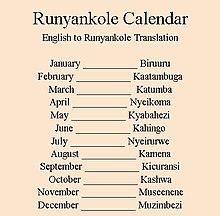Kingdom of Ankole Obugabe Bwa Ankore | |
|---|---|
| 1478–1967 | |
Anthem: 'Ensi Nkore, Ensi Nkore' | |
.gif) Location of Ankole (red) in Uganda (pink). | |
| Status | Kingdom |
| Capital | Mbarara[1] |
| Common languages | Runyakole |
| Ethnic groups | Banyankole |
| Government | Constitutional monarchy |
• Omugabe | Prince Charles Rwebishengye |
• Enganzi | N/A |
| History | |
• Established | 1478 |
• Disestablished | 1967 |
| Area | |
• Total | 16,104 km2 (6,218 sq mi) |
| Population | |
• Estimate | 4.1 Million |
| Currency | Uganda Shillings (UGX) |
| Time zone | UTC+3 (EAT) |
| Calling code | 256 |
Ankole (Runyankore: Nkore), was a traditional Bantu kingdom in Uganda. The kingdom is located in south-western Uganda, east of Lake Edward. It was ruled by a monarch known as the Mugabe or Omugabe. The kingdom was formally abolished in 1967 by the government of President Milton Obote, and since then, the kingdom has not been restored officially.[2] The people of Ankole are called Banyankole (singular: Munyankole) in Runyankole language, a Bantu language.
On 25 October 1901, the Kingdom of Nkore was incorporated into the British Protectorate of Uganda by the signing of the Ankole agreement.[3]
Because of the reorganisation of the country by Idi Amin, Ankole no longer exists as an administrative unit. It is divided into ten districts, namely: Bushenyi District, Buhweju District, Mitooma District, Rubirizi District, Sheema District, Ntungamo District, Mbarara District, Kiruhura District, Ibanda District, and Isingiro District.
Location
Ankole Kingdom is located in the South-Western region of Uganda bordering Rwanda and the Democratic Republic of Congo
List of Omugabe of Ankole
- Ruhinda, late fifteenth century
- Nkuba, late fifteenth century
- Nyaika, early sixteenth century
- Ntare I, mid sixteenth century
- Rushango, late sixteenth century
- Ntare II, late sixteenth century/early seventeenth century
- Ntare III, mid seventeenth century
- Kasasira, late seventeenth century
- Kitra, late seventeenth century
- Rumongye, late seventeenth century
- Mirindi, late seventeenth century
- Ntare IV, c. 1699–c. 1727
- Macwa, c. 1727–c. 1755
- Rwabirere, c. 1755–1783
- Kahaya I, 1783–?
- Rwebishengye, ?–1811
- Kayungu, 1811–?
- Gasyonga I, ?–1839
- Mutambuka, 1839–1873
- Ntare V Rugingiza, 1873–1895
- Kahaya II, 1895–1944
- Gasyonga II, 1944–1967
- Monarchy discontinued by the Ugandan government, 1967–present
- Ntare VI/John Barigye, 1993–2011 (Titular king)
- Charles Rwebishengye, 2011–present (Titular king/crown prince)
Nkole people
Nkole people are a Bantu ethnic group native to Uganda. They primarily inhabit Ankole. They are closely related to other Bantu peoples of the region, namely the Nyoro, Kiga, Toro and Hema peoples. Their population is 4,187,445(9.8% of Uganda). There are several names they are referred to as. These include the following ones: Ankole, Ankori, Banyankole, Banyankore, Nkoles, Nkore, Nyankole, Nyankore, Ouanyankori, Runyankole, Runyankore, Uluyankole, Uluyankore. The Nkole speak Orunyankore, a Great Lakes Bantu language. There were an estimated 2.3 million native speakers in 2002.
Ankole history
Bairu and Bahima clans
Banyankore trace their ancestors back to the Bairu and the Bahima subgroup.[4]
Kingdom abolished
The kingdom was abolished in 1967 by the Ugandan government under president Apollo Milton Obote.[4]
Counties of Nkole (Amashaza)
Nkore Kingdom was divided into ten counties. These counties are now divided into various political constituencies. But the original ten counties of Nkore include:
- Kashari
- Isingiro
- Rwampara
- Nyabushozi
- Ibanda
- Sheema
- Kajjara
- Bunyaruguru
- Igara
- Buhweju
Nkole calendar
The Nkore calendar was divided into 12 months. They were named according to weather conditions and activities done in that period. They include:
- Biruuru
- Kaatambuga
- Katumba
- Nyeikoma
- Kyabahezi
- Kahingo
- Nyeirurwe
- Kamena
- Kicuransi
- Kashwa
- Museenene
- Muzimbezi
References
- ^ Briggs, Philip; Roberts, Andrew (5 November 2016). Uganda. Bradt Travel Guides. p. 534. ISBN 9781784770228. Retrieved 29 December 2016.
- ^ The Observer Media Ltd. :: The Weekly Observer :: Uganda's Top Resource site Archived 3 December 2007 at the Wayback Machine
- ^ The Ankole Agreement 1901
- ^ a b "Runyakore History and Culture" (PDF). Runyakore L&C. 26 January 2021.
External links




